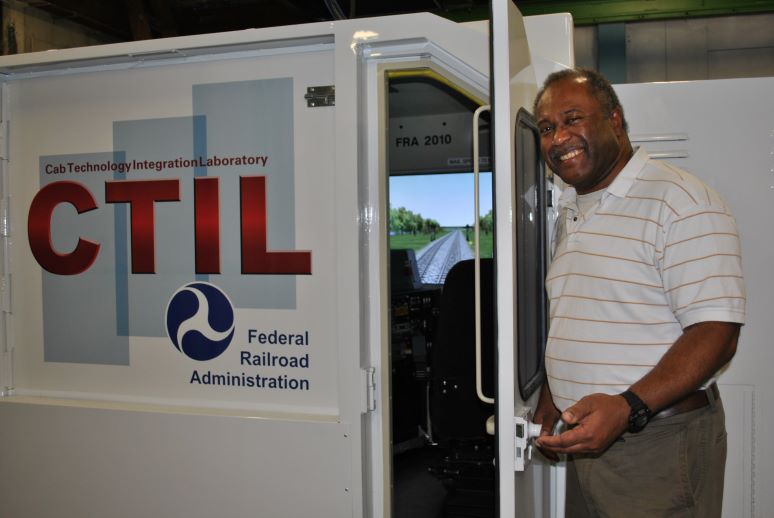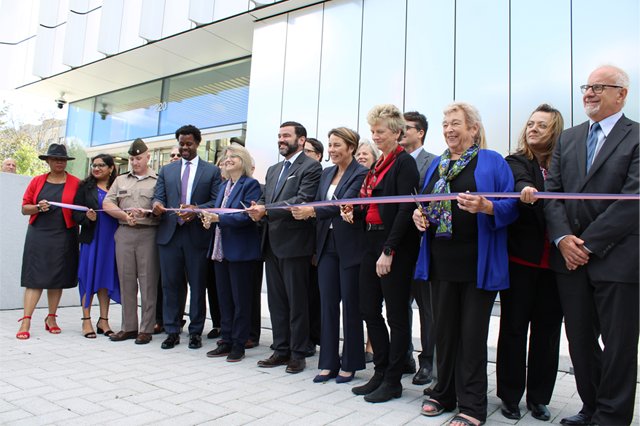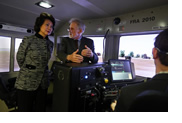News and Updates
CTIL Program Manager Mike Jones Retires, Donnie Tweedie Assumes Role (June 2025)
Michael “Mike” Jones, of FRA’s Research, Development and Technology (RD&T) Division, has retired after more than 30 years of service in the Federal Government, including two decades at the FRA. During his tenure at FRA, Mike identified the need for a high-fidelity locomotive cab simulator that would enable human performance safety research related to technology and procedures. To address this need, he led the acquisition of the Cab Technology Integration Laboratory (CTIL) and served as CTIL Program Manager, successfully guiding the research agenda and working with stakeholders across academia, the private sector, industry, and government. Donald “Donnie” Tweedie will assume the role of CTIL Program Manager going forward, with Volpe staff continuing to house and operate the simulator. We wish Mike all the best in his retirement!

Ribbon-Cutting Ceremony for New U.S. DOT Volpe Center Facility (September 2023)
On September 19, 2023 U.S. DOT leadership, state and local partners, and partners from the U.S. General Services Administration (GSA) and the Massachusetts Institute of Technology (MIT) cut the ribbon to officially mark the opening of the new U.S. DOT Volpe Center facility, which houses the Cab Technology Integration Laboratory (CTIL).

CTIL Moves to New U.S. DOT Volpe Center Facility (June 2023)
On June 7, 2023 the Cab Technology Integration Laboratory (CTIL) was moved to Volpe's new facility located at 220 Binney St, in Kendall Square. The several thousand-pound aluminum locomotive simulator was hoisted onto a flatbed truck using steel pipes and a forklift, then driven over and unloaded through the garage door to the Human Factors Lab. CTIL was the first simulator to be moved into the new state-of-the-art facility; the remaining simulators will be moved over the summer. Watch the video below to see five hours of work condensed into two minutes.
FRA Launches the CTIL Clean-Ops Plan (October 2020)
In coordination with the Federal Railroad Administration (FRA), the Volpe Center developed the Cab Technology Integration Lab (CTIL) Clean-Ops Plan (available on the Reports and Presentations webpage), which details the health and safety precautions that the lab will take when conducting human-subjects research to protect the health and well-being of research participants and experimenters during the COVID-19 pandemic.
Happy 10th Anniversary to FRA’s Cab Technology Integration Lab (March 2020)
FRA’s Cab Technology Integration Lab (CTIL) celebrated its tenth anniversary in March, 2020. Operated and maintained at the Volpe National Transportation Research Center in Cambridge, MA, the CTIL provides a simulated locomotive cab environment that examines the safety risks of new technologies, and seeks to advance the boundaries of operator capability and performance to improve safety through human factors and systems research.
During the past 10 years, researchers have studied a wide variety of topics, ranging from engineer crewstation design, to head-up displays, to mitigating in-cab distractions. Findings from CTIL research are made available through technical reports and briefings at transportation and rail industry conferences. (See the Reports and Presentations webpage.) The research itself has also resulted in invention disclosures, applications for copyright and patents for products that could make locomotive operations safer, as well as addressing one of the safety recommendations the National Transportation Safety Board (NTSB) made to FRA.
One of the program’s strengths is that it brings together a wide variety of stakeholders to work together on research projects and consider research needs. Through industry stakeholder meetings, leaders from labor unions, railroad management, and academia discuss ongoing research projects as well as emerging safety and performance issues that further research in the CTIL can address.
Second CTIL/Automation Stakeholder Meeting (September 2019)
The Human Factors Division facilitated a second meeting with automation stakeholders from across the rail industry. Building on the momentum from the January meeting, the discussion focused on findings / results of three FRA automation research projects and strategies for acquiring and implementing automation. (Presentations available on the Reports and Presentations webpage.) There was a robust discussion and Q&A with FRA’s research partners regarding use of augmented reality in head-up displays, artificial intelligence / machine learning in object detection, and investigation into human-induced errors in already-fielded automation. The group also highlighted a need and opportunity for development of guidance and standards for implementing automation and the importance of considering human performance in the systems design process. Further, FRA highlighted that the CTIL lab provides a test and evaluation capability that can be adjusted to fit a wide range of scenarios to examine any human interface associated with cab automation. In response to this valuable stakeholder input, FRA will propose new work to provide human factors design guidelines to address automation implementation.
FRA Publishes Strategic Plan for the CTIL (August 2019)
FRA published a strategic plan that establishes a path for cab automation research and use of the Cab Technology Integration Laboratory (CTIL) to advance railroad safety by using human-in-the-loop simulation and modeling research to improve locomotive crew performance. Read the report on the Reports and Presentations webpage.
The CTIL Gains New Northeast Corridor Track and Passenger Console (June 2019)
 The CTIL acquired two exciting new resources facilitating human performance research in the passenger domain. The first is a new engineer’s console, modeled after the Siemens ACS-64 console, with special modifications allowing it to be integrated with the CTIL. It includes additional software capabilities that enable creation of highly realistic operational scenarios, including passenger platforms that can be populated with animated figures. Animated people can also be included in scenarios to study crew detection and reaction to trespassers, and at grade crossings in a much more realistic way than previous CTIL functions. Secondly, the CTIL has acquired new track – the Northeast Corridor, from Wilmington, DE, to Penn Station, New York, NY.
The CTIL acquired two exciting new resources facilitating human performance research in the passenger domain. The first is a new engineer’s console, modeled after the Siemens ACS-64 console, with special modifications allowing it to be integrated with the CTIL. It includes additional software capabilities that enable creation of highly realistic operational scenarios, including passenger platforms that can be populated with animated figures. Animated people can also be included in scenarios to study crew detection and reaction to trespassers, and at grade crossings in a much more realistic way than previous CTIL functions. Secondly, the CTIL has acquired new track – the Northeast Corridor, from Wilmington, DE, to Penn Station, New York, NY.
The CTIL Team Hosts Stakeholder Meeting (January 2019)
The CTIL team organized a meeting to bring together CTIL stakeholders and CTIL decision makers to facilitate mutual learning and inform FRA’s research agenda. The overall purpose of the meeting was to ensure that the research that comes out of the CTIL lab is of value to the industry and likely to be used. The primary focus of discussions during the meeting was to identify operational safety issues related to partial automation and in-cab technologies more generally.
The CTIL Gains New Head-Up Display (HUD) Technology (August 2017)
Researchers at MIT’s Human Systems Laboratory have developed a new HUD prototype display that has become part of the CTIL. This display was developed using virtual reality software that allows for development of traditional HUD and augmented reality–style displays on the engineer’s front windscreen. The HUD projection uses green-screen technology and is not affected by occlusion or glare. These tools enable researchers to develop and test a wide range of display features.
Secretary Elaine L. Chao Visits the CTIL (April 2017)

U.S. Secretary of Transportation Elaine L. Chao visited the Volpe Center on April 21, 2017. During her visit, Secretary Chao took part in a tour of the CTIL, which included a demonstration of its capabilities.
The CTIL Acquires Exciting New Equipment and Capabilities (March 2017)
Several pieces of FRA-owned equipment have been permanently relocated to the CTIL at the Volpe Center. These include:
- Xsens Kinematic Measurement System: This wireless motion-tracking system records detailed operator body movements and facilitates biomechanical analysis.
- Mobile Eye-XG: This tool enables researchers to obtain real-time gaze information of operators. The Mobile-Eye XG creates a video stream of the engineer’s gaze overlaid on a rear-cab or head-mounted camera feed and can be used to pinpoint where the subject is looking within their field of view.
- 5 Camera 60 Hz Smart Eye Pro 5: This eye-tracking technology is unique in that it records real-time gaze information without the need for operators to wear specialized equipment. CTIL’s version of the Smart Eye Pro 5 includes four cameras, allowing the system to record data on a 3D field of view. (For other eye-tracking technologies also available in the CTIL, visit the "Capabilities" section.)
- 3D Whole Body Scanner: This system provides a non-invasive way of obtaining anthropometric data and can be used as part of a process for improving the accuracy of ergonomic studies in rail transportation.
The CTIL's Research Panel Session at TRB Annual Meeting (January 2017)
Researchers who performed studies in the laboratory shared their findings during a CTIL-themed panel discussion at the 2017 Transportation Research Board (TRB) Annual Meeting. The session, titled “Using Rail Simulation to Understand the Human Factors Implications of New Technologies,” included discussion of four different studies conducted by researchers with the Volpe Center, UMass Amherst, Alion Science and Technology, and GE Global Research. (Presentations are available on the Reports and Presentations webpage.)
